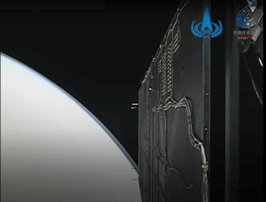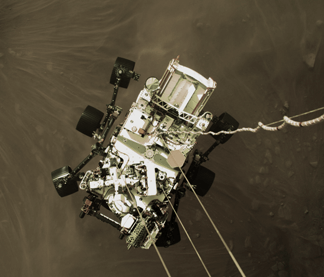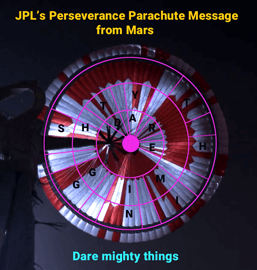
April 2021 - Vol. 25, No. 4
This Month's Night Sky - NOTE: The next paragraph describes the sky as it appears at 10 pm EST (11 pm EDT) near mid- month. The sky also looks this way at 11 pm EST (midnight EDT) during the beginning of the month and at 9 pm EST (10 pm EDT) by month's end.
As the days lengthen, the stars of the Winter Triangle fade into evening's dusk. The "Big Dipper" asterism (Ursa Major) is well placed for viewing this month since it is almost directly overhead. Follow the curve of its handle to Arcturus (Bootes) and continue on the curve to Spica (Virgo). Regulus (Leo) is on the ecliptic (the path traced by the planets and Moon), just W. of overhead. Further W., on the ecliptic, find the Gemini Twins, Castor and Pollux, and finally the Pleiades asterism of Taurus. So far this year, Mars and Aldebaran have been hanging out together, providing a nice double orange star display.
MERCURY is a difficult object this month, reaching superior conjunction on the 19th. VENUS may be spotted in the evening twilight sky late in the month. MARS in the evening sky will start out at 1.3 mag dimming to 1.6 by month's end. JUPITER rises in the morning sky moving into Aquarius late in the month. SATURN rises before the giant planet in Capricornus. URANUS is in Aries, moving toward conjunction with the Sun by month's end. NEPTUNE rises in the morning twilight sky.
Review how to determine Angular Measurement.
Calendar of Events
NOTE: For those observers not in the ET zone, convert the calendar times to your zone's time by subtracting one hour for CT, two for MT and three for PT. Don't forget to adjust for Daylight Savings Time when necessary by subtracting one hour from your planisphere's time. Dawn and dusk times must also be corrected. See your local newspaper, TV news, or cable TV's Weather Channel for sunrise and sunset times or check with the U.S. Naval observatory. Unfortunately some of these events may occur during daylight hours in your area.
| DATE | EVENT |
| 03 | Mercury at greatest heliocentric lat. S. |
| 06 | Saturn 4 deg. N. of Moon. |
| 07 | Jupiter 4 deg. N. of Moon. Double transits of Jupiter's moons shadows if observing with a telescope. Serious observers should consult accurate sources for local circumstances. |
| 11 |
Mercury 4 deg. N. of Moon. Neptune in conjunction with Sun. |
| 14 | Moon at apogee. |
| 17 | Mars 0.1 deg N. of Moon, occultation from parts of Africa, S. Middle East, India, SE Asia, Indonesia, and Phillipines. |
| 18 | Moon 0.9 deg. N. of M-35 star cluster. |
| 19 | Mercury at superior conjunction. |
| 22 | Lyrid meteor peak. The shower is estimated to contain 20 meteors at peak, this year the Moon a few days after full and may interfere with early morning observations. |
| 27 |
Moon at perigee, expect large tides. Mercury at perihelion. Mars 0.5 deg. N. of M-35 |
| 30 | Uranus in conjunction with the Sun. |
Lunar Almanac for April 2021
| Phases of the Moon | Phase and Date(s) | Best viewed before local midnight |
 |
New 11 |
Deep Space Objects |
 |
1st. Qtr 20 |
Planets & Moon |
 |
Full 28 |
Moon |
 |
Last Qtr 04 |
Deep Space & Planets |
Topic of the month: Missions to Mars
While the 2020 opposition of Mars is drawing to a close, the spacecraft launched in 2020 are safely at Mars and preparing to carry out their missions. United Arab Emirates (UAE) Al-Amal or "Hope", China National Space Administration (CNSA) Tianwen, and the United States NASA's Perseverance Rover have all arrived at the red planet. February was a very exciting month for Mars exploration, so we are summarizing the activities of these new Mars probes. NASA also dropped the hint that the Jet Propulsion Laboratory left a special message in the parachute they sent to Mars. We'll decode the message at the end of this article.
UAE Al-Amal Mission

On February 9, the first spacecraft launched toward Mars in July of 2020 was the United Arab Emirates' Mars mission Al-Amal. This spacecraft entered into Mars orbit on February 9, 2021. It will study the atmosphere of Mars, returning details that have not yet been uncovered. The orbit will allow the spacecraft to view weather over large areas of the planet over time. It is expected to begin its mission in May 2021 and send back information for 2 years. The Al-Amal mission is the responsibility of AEU's space agency Mohammed Bin Rashid Space Centre (MBRSC).
Al-Amal's engines fired for 27 minutes to be captured by Mars' gravity and insert itself into orbit around the red planet. This is known as Mars Orbit Insertion (MOI) maneuver. Because of the communication time delay between Mars and Earth, spacecraft need to be able to perform MOI autonomously. The successful arrival and orbital insertion makes the Al -Amal spacecraft the first UAE planetary mission and the the fifth space agency to reach Mars orbit successfully.
After 40 hours traveling in the capture orbit, Al-Amal will enter into its science orbit. It uses a type of orbit that is called a semi-synchronous orbit. It orbits Mars once every 55 hours while the rotational period of Mars is 24 hours and 37 minutes. This means that Al-Amal will be above certain regions of Mars for longer time periods that will allow an overview of weather patterns.
CNSA Tianwen Mission

China's Tianwen spacecraft, in an orbiter, lander, and rover all-in-one. It is the first Chinese mission sent to Mars. The design for this spacecraft is based on CNSA's successful missions to the Moon and lunar surface. Last year, CNSA sent a sample mission to the lunar surface and returned specimens to Earth in 23 days. The Chang'e 5 mission returned 2 kilograms or 4.4 pounds of lunar samples. Tianwen means "heavenly questions" named after a poem by Qu Yuan, a 3rd century poet. On February 11, Tianwen reached Mars and successfully performed the MOI maneuver. The spacecraft performed a 15-minute burn to slow down for Mars capture.
The image of the insertion maneuver here was captured from the CNSA video. The camera used was mounted on the solar array. It captured some details of the Martian surface including craters, ridges, and other terrain features, but what really got me excited was the view it took on the limb of the red planet where the atmosphere of Mars was revealed. Close examination will even show layers in the atmosphere. It is very impressively thin!
The target landing place for the lander and the rover is Utopia Planitia , the huge basin where the successful Viking 2 probe landed in 1976. The rover will be sent to the surface in May 2021, after the orbiter has located the best landing site for touchdown. The rover is solar powered and is expected to last 3 months on the surface. The landing craft will use aerobraking, parachutes, thrusters, and airbag to achieve a soft touchdown on Mars.
On February 24, Tianwen-1 entered parking orbit, with its closest point (periareon) to the planet at 280 km and the farthest point (apoareon) at 59,000 km. The Tianwen spacecraft carries 13 instruments. The orbiter is equipped with 2 cameras, a magnetometer, mineral spectrometer, radar, and two particle analyzers. The Rover has ground-penetrating radar, a surface magnetic field detector, a weather station, and 3 cameras.
NASA Perseverance Rover Mission

Mars Perseverance is NASA's 5th rover to land successfully on Mars. The Perseverance Rover builds on the success of NASA’s Curiosity rover, that means that some of the hardware (cruise stage, descent stage, and aeroshell/heat shield) uses the components from the previous mission. Perseverance rover is roughly car-sized: ~10 feet long, 9 feet wide, and 7 feet tall (or ~3 m long, 2.7 m wide, and 2.2 m tall). It weighs 2,260 pounds (1,025 kg) and is the heaviest rover NASA has ever sent to Mars. Surface operations are expected to last at least one Mars year or 687 Earth days.
Perseverance or "Persy" reached Mars on February 18, performing its autonomous landing on the Martian surface during the "seven minutes of terror" when NASA was unable to affect the process. Earthbound observers were quite excited when the engineering team pronounced "Tango Delta" or TD for touchdown. Of course, the signal didn't arrive until after the spacecraft had already landed.
The image here shows the rover as it is being carried to the surface by the Sky Crane. This is one of the earliest pictures released by NASA, but the agency has since posted many pictures on its website. Engineering cameras were mounted on the Sky Crane and on the Rover, so that the two complex robots can be studied to improve future missions. Percy also has a microphone on board and NASA has already released the sounds of wind on Mars. It is hoped that there will be more interesting sounds once the rover starts moving, but we have to keep in mind that the martian environment won't be friendly to delicate instruments.

During a press release, NASA told viewers that its parachute contained an hidden message. Mission engineers wanted to include some pattern in the fabric of the parachute so that they could tell which way it was oriented while the spacecraft were descending to the surface. It wasn't long after the press conference that the message was decoded on the internet.
Ian Clark, an engineer working on the Perseverance mission decided that he would make it a little fun. He used binary code to spell out, "Dare Mighty Things" a JPL motto. (This was originally a quote by Theodore Roosevelt.) Using 2 colors, Ian was able to encode the message in binary with 1 being orange and 0 being white. For the main message, the numbers have to be matched up with alphabet letters starting with A = 1. We made a graphic of our own showing how this was accomplished. Along the border of the chute, the code is 34 11 58 N 118 10 31 W or 34 deg. 11 min. 58 sec. N. 118 deg. 10 min. 31 sec. W., the latitude near the Jet Propulsion Laboratory's visitor center.
Perseverance Rover is one of the most sophisticated robots ever sent to Mars. In addition to moving about in Jezero crater looking for life, Persy also carries a small helicopter named "Ingenuity". Although it is small, Ingenuity is the first attempt at powered flight from the Mars surface. A technology demonstration, Ingenuity has its own batteries and it is hoped that it will fly for at least a month. Another function of the rover is caching samples to be returned to Earth by a future Mars mission.
For more information on the spacecraft that arrived at Mars in February 2021, check out Astra's Mars 2020 Exploration page.
--See You Under the Stars!
Astra for Astra's Almanac
This installment of "What's Up?" is ©2021 by Dawn Jenkins for Astra's Stargate. View Ron Leeseburg's Farewell Issue for information on where to find information such as is presented in this almanac.